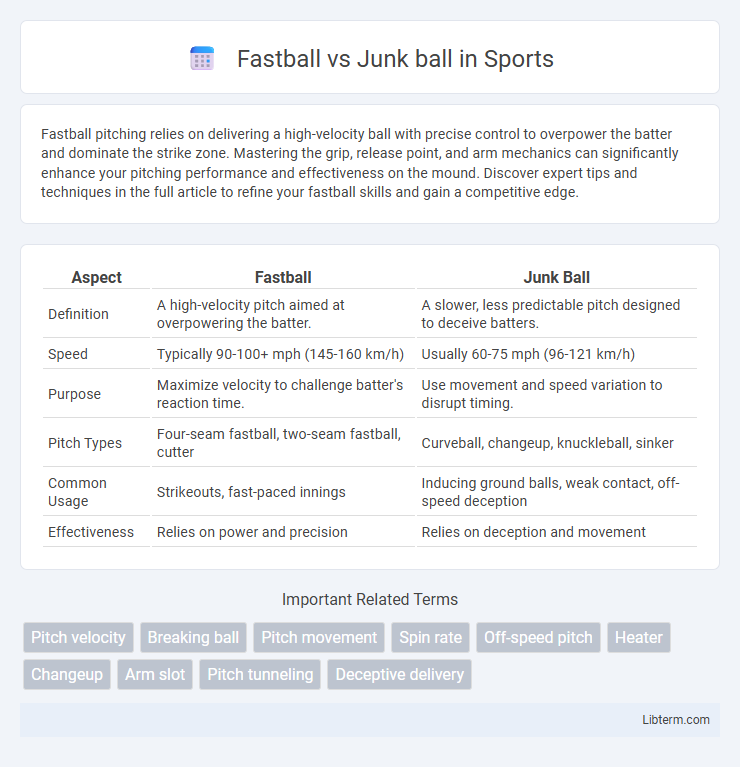Fastball pitching relies on delivering a high-velocity ball with precise control to overpower the batter and dominate the strike zone. Mastering the grip, release point, and arm mechanics can significantly enhance your pitching performance and effectiveness on the mound. Discover expert tips and techniques in the full article to refine your fastball skills and gain a competitive edge.
Table of Comparison
| Aspect | Fastball | Junk Ball |
|---|---|---|
| Definition | A high-velocity pitch aimed at overpowering the batter. | A slower, less predictable pitch designed to deceive batters. |
| Speed | Typically 90-100+ mph (145-160 km/h) | Usually 60-75 mph (96-121 km/h) |
| Purpose | Maximize velocity to challenge batter's reaction time. | Use movement and speed variation to disrupt timing. |
| Pitch Types | Four-seam fastball, two-seam fastball, cutter | Curveball, changeup, knuckleball, sinker |
| Common Usage | Strikeouts, fast-paced innings | Inducing ground balls, weak contact, off-speed deception |
| Effectiveness | Relies on power and precision | Relies on deception and movement |
Introduction to Fastball and Junk Ball
The fastball is a high-velocity pitch primarily aimed at overpowering the batter, typically thrown at speeds exceeding 90 mph with minimal movement. The junk ball refers to slower, off-speed pitches such as curveballs, sliders, and changeups that rely on deception and breaking movement rather than speed to disrupt the hitter's timing. Both pitch types form the foundation of pitching strategy, balancing velocity and deception to challenge batters effectively.
Defining the Fastball: Speed and Power
The fastball is characterized by its high velocity, often exceeding 90 mph, making it one of the most powerful pitches in baseball. Pitchers rely on a combination of arm strength and precise mechanics to maximize speed and maintain a straight trajectory. This pitch contrasts sharply with junk balls, which prioritize deception and reduced speed over sheer power.
Understanding the Junk Ball: Deception and Variety
The junk ball relies heavily on deception and variety, using off-speed pitches like the curveball, changeup, and slider to disrupt the batter's timing. Unlike fastballs that prioritize speed, junk pitches emphasize movement, location, and unpredictability to confuse hitters. Mastering a diverse junk ball arsenal allows pitchers to effectively counter aggressive batters by making each pitch difficult to anticipate.
Mechanics: How Fastballs and Junk Balls Differ
Fastballs rely on maximum arm speed and a straightforward arm path to generate high velocity, typically between 90-100 mph, making precise release point and grip crucial for control and movement. Junk balls, such as curveballs, sliders, and changeups, emphasize altered wrist action, grip pressure, and arm speed variations to reduce velocity and create deceptive movement, often breaking away from the hitter. Differences in biomechanics between fastballs and junk pitches lie in finger pressure, wrist snap, and arm slot adjustments, impacting pitch trajectory and spin rate.
Effectiveness Against Batters
The fastball's high velocity challenges batters by reducing reaction time, making it effective for overpowering hitters and generating strikeouts. Junk balls, including curveballs and changeups, rely on deception through varied speeds and movement, disrupting timing and inducing weak contact or ground balls. Effectiveness against batters depends on pitch sequencing and location, with fastballs dominating aggressive hitters and junk balls exploiting timing weaknesses.
Situational Usage: When to Throw Each Pitch
Use a fastball when you need to challenge the hitter with speed or establish control early in the count, especially in predictable counts like 0-0 or 1-0 to set up secondary pitches. Employ a junk ball, such as a curveball or changeup, in hitter-friendly counts or when aiming to disrupt timing, typically in 2-2 or 3-2 counts where deception is key. Strategic deployment of each pitch type depends on the batter's tendencies, game situation, and desired outcome, maximizing pitching effectiveness.
Player Profiles: Famous Fastball Pitchers vs. Junk Ballers
Famous fastball pitchers like Nolan Ryan and Aroldis Chapman are renowned for their high-velocity pitches exceeding 100 mph, relying on raw power and precision to overpower hitters. Junk ballers such as Greg Maddux and Jamie Moyer excel in deception, using off-speed pitches, breaking balls, and exceptional control to disrupt hitters' timing. Player profiles highlight that fastball pitchers often dominate with athleticism and speed, while junk ballers thrive through strategy and mastery of pitch variety.
Training Techniques for Each Pitching Style
Training techniques for fastball pitchers emphasize building arm strength and improving velocity through weighted ball exercises, long toss programs, and plyometric drills to enhance explosive power. Junk ball pitchers focus on developing pitch control and movement by practicing grip variations, spin manipulation drills, and deception patterns to master changeups, curveballs, and sliders. Both styles require consistent bullpen sessions to refine mechanics and maintain arm health through targeted stretching and recovery protocols.
Pros and Cons: Fastball vs. Junk Ball
A fastball offers high velocity and control, making it effective for overpowering hitters but can be predictable and easier to time. Junk balls, including pitches like curveballs and changeups, rely on deception and movement to disrupt timing, though they often sacrifice speed and may lack consistency. Mastering both pitch types enhances a pitcher's versatility by balancing power with strategic finesse.
The Evolution of Pitching Strategies in Baseball
The evolution of pitching strategies in baseball reflects a dynamic shift from reliance on fastballs toward the incorporation of junk balls, such as curveballs, sliders, and changeups, to disrupt hitters' timing and increase pitch deception. Modern pitchers leverage advanced analytics and biomechanical insights to optimize pitch selection, balancing velocity with off-speed and breaking pitches for strategic advantage. This blend of power and finesse marks a significant progression in pitching philosophy, emphasizing adaptability and precision over mere speed.
Fastball Infographic

 libterm.com
libterm.com